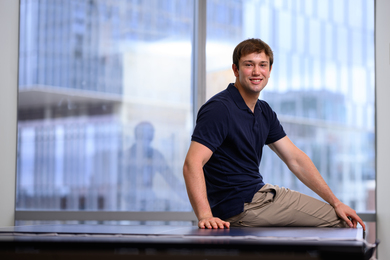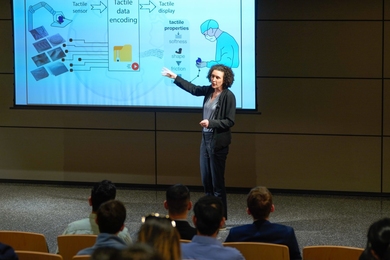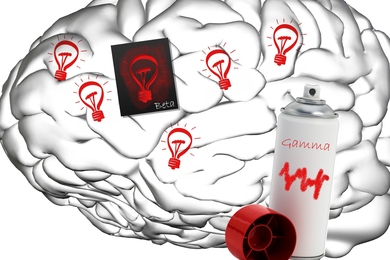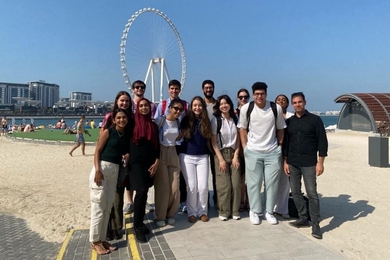Most medical researchers focus tightly on a narrow set of diseases or technologies. Jeffrey Karp looks instead across a broad smorgasbord of medical issues where innovative bioengineering can make a big difference in a relatively small amount of time.
“In my laboratory, we bring together people from diverse backgrounds,” says Karp, an affiliate faculty member at the Harvard-MIT Division of Health Sciences and Technology and associate professor at Harvard Medical School and Brigham and Women’s Hospital. “We have chemical engineers, immunologists, basic biologists, materials scientists, polymer engineers, and clinicians. We work very collaboratively, and we like to pick problems where there’s opportunity for translation in the near future.”
These multidisciplinary teams at the Karp Lab often turn to nature for inspiration. “Evolution is the best problem solver, with millions of years of research and development,” Karp remarks. “Every living thing is here today because it has solved an incredible number of challenges. We’ve tried to overcome challenges on translational projects by turning to creatures such as porcupines, parasitic worms, cactus needles, slugs, snails, and spider webs. All of these examples in nature have provided insight that we would never have had by just staying inside of the lab.”
Karp also works very closely with major industry partners. “Through those experiences, I’ve really learned so much about what happens when a technology leaves the lab,” he says. “It’s so important to understand the environment in industry — how one approaches problems, how one thinks about advancing solutions, and what specific criteria are imposed. In our new projects, we can impose some of these criteria, and maximize the potential for these projects to make it in the real world.”
His lab currently has five main themes in translational research: tissue adhesives, drug delivery, stem cell therapies, diagnostic systems, and medical devices. Researchers also are open to take on other puzzles that don’t fit precisely into these themes — among them, ways to make batteries safer.
Delivering therapies in difficult environments
Karp’s work in tissue adhesives, a good illustration of his approach to bioengineering, began with a request from Pedro Del Nido, chief of cardiac surgery at Boston Children’s Hospital. Del Nido wanted to find a better way to treat newborns with holes in their hearts, by gluing a degradable patch inside the heart, over which the heart eventually could regrow a tissue bridge.
Achieving such a patch would be no small trick. The heart is arguably the most challenging environment inside the human body, Karp remarks, and the patch would have to degrade slowly as it gathered cells for the new tissue bridge. Most critically, its glue could not react or be diluted with blood.
Taking clues from slugs, snails, and sand castle worms, the researchers created a viscous glue that repels water. “We thought, if we push this against the wall of the heart, it would just push the blood away,” he says. “If we made it viscous, just like the secretions that you see in nature, it would remain in place long enough to cure it.”
They also developed a patch that was fully degradable, elastic, and transparent (so the glue could be cured by exposing it to light). The patch with a thin layer of glue worked successfully in live animal tests, and the approach also worked well for sealing large arteries. In 2013 Karp launched a startup, Gecko Biomedical, in collaboration with MIT Institute Professor Robert Langer. The company plans to begin human testing this December.
Among its drug delivery efforts, the Karp Lab has developed a gel that can deliver therapies only when the local environment in the body is inflamed. This promises more optimal treatment of inflammatory conditions that range from arthritis to ulcerative colitis. The approach also may locally boost and sustain immunosuppression after an organ transplant, and Karp is working with a number of collaborators to bring it to clinical trials.
Another lab concentration is in stem cell therapies. Researchers in this field have made dramatic advances in recent years in the ability to bioengineer human cells of almost any type. The Karp Lab is developing technologies that help these engineered cells get to the right locations and perform their designated jobs.
Some of these technologies help to control the surface of the cells, so that after the cells are infused into the body they target the site where they are needed — for instance, if someone has peripheral vascular disease in one region of their body, cells could be sent there to help grow new blood vessels.
Even more dramatically, Karp and his colleagues have figured out a way to control such engineered cells from the inside out, by loading them with nano- or micro-particles that contain small molecules. Once the particles are internalized, they can slowly release the small molecules inside the cell. The technology promises to help control how the cell develops within the body or to help it secrete molecules that aid in therapy, among other benefits.
In another effort, Karp figured out a way to deliver particles to the skin that can capture nickel and other allergens or irritants to prevent them from causing a reaction. The technology was rapidly translated into a skin-care product that is sold in drug stores in Europe and the United States as well as on Amazon.com. Skintifique, a startup that he co-founded, now has multiple offerings for people with various challenging skin conditions.
Different thinking on devices
Unsurprisingly, the lab’s efforts in diagnostic and other medical devices also cover a wide spectrum.
One key thrust is in finding ways to capture circulating tumor cells, which are shed from solid tumors into the bloodstream. These cells can offer the chance to study a metastatic tumor when a biopsy is difficult or impossible, and they hold high promise for clinical use as well. But they are extremely rare and difficult to collect.
In the Karp Lab, the key insight for a better capture device came from jellyfish tentacles. “We developed a surface of a device with long tentacles made out of DNA that could bind to the surface of cancer cells and extend very far away from the surface of the device,” Karp says. “We showed that we were able to capture cells in blood at 10 times the flow rate of other devices that had been proposed, and we could achieve that with the same high capture efficiency.”
The lab also has reimagined a very familiar device, the hypodermic needle, working with the labs of Alexander Slocum, MIT professor of mechanical engineering, and Omid Farokhzad, associate professor at Brigham and Women’s Hospital and at Harvard Medical School.
Their rethinking aimed to overcome a common and sometimes dangerous problem: When a clinician is inserting a needle deep into the body, it’s difficult for the clinician to know when to stop. But Karp and his colleagues came up with a design for a needle that knows. “Regardless of how hard the clinician is pushing on the needle, it automatically stops when it gets to a region of the body with lower resistance or an open cavity,” he says.
Preventing assault with (a) battery
A very different kind of project aims to prevent another kind of complication, this one from a non-medical device.
Button cell batteries (also called coin batteries) power millions of toys, watches, musical greeting cards, hearing aids, and other portable electronics. They are small enough that a child can easily swallow one accidentally. That has happened more than 73,000 times in the past 30 years in the United States, and almost half of these accidental ingestions lead to injury, Karp says.
Setting out to solve the problem, his team noticed that batteries are spring-loaded into devices, which creates greater force than the batteries encounter when swallowed. That realization led them to create a pressure-sensitive coating made of compressible silicon embedded with metal microparticles. “When you place a battery with this coating into a device, the spring of the device pushes on the coating and converts it from an insulator to a conductor,” he says. “If you swallow the battery accidentally, the forces of the gut are not strong enough to convert that coating to a conductor, so it remains an insulator, and it’s fully waterproofed.”
Tests of coated batteries in stomach acid and in animals showed that the coating does guard against formation of an electrical current and leaks of battery acid. After publishing a paper on the technology, his team was contacted by patient safety advocacy groups, government agencies, and battery manufacturers. “We’re very interested in working with industry partners on this battery technology,” Karp says. “Not only can it enable safer batteries, but we’ve developed a strategy to weatherproof batteries that will have a lot of applications in the military or in harsh environments.”









